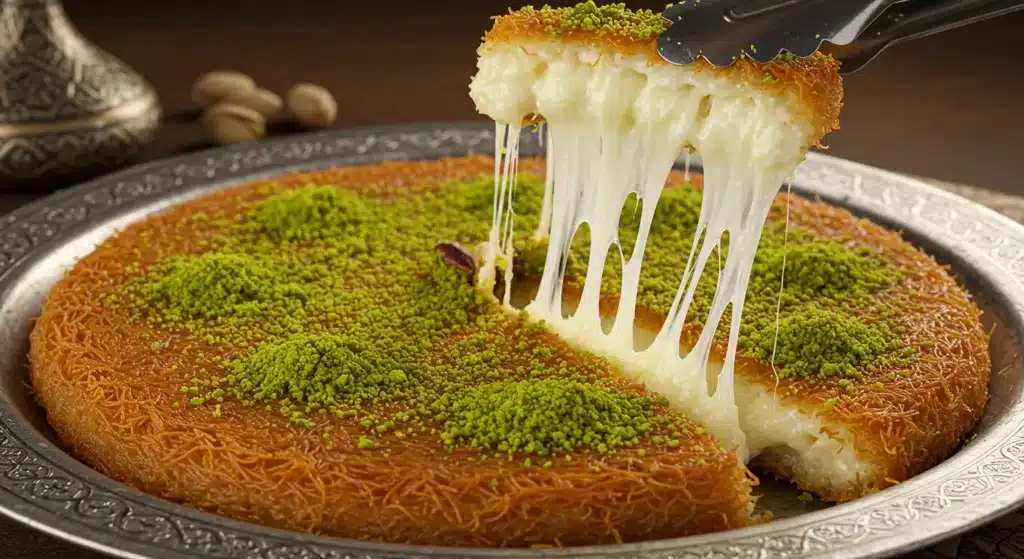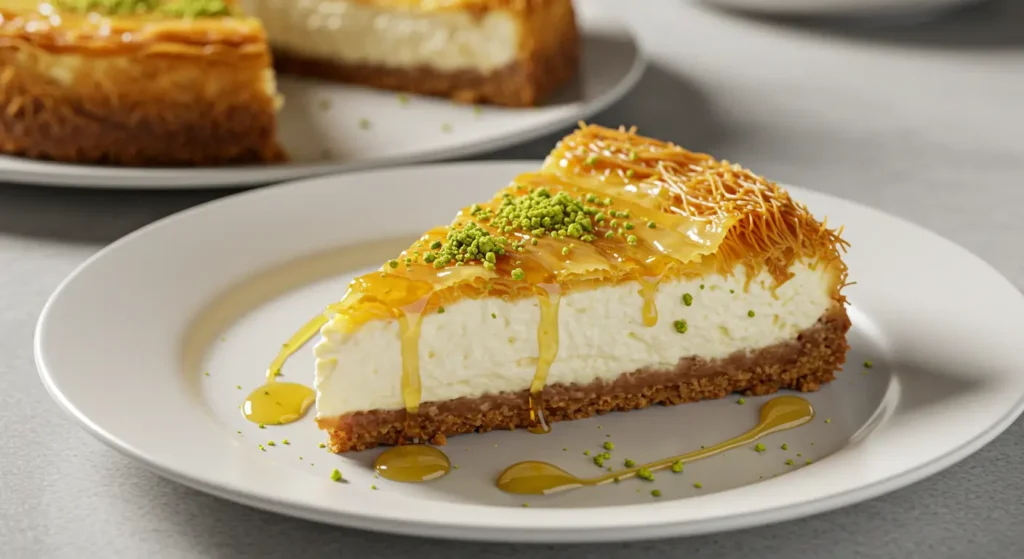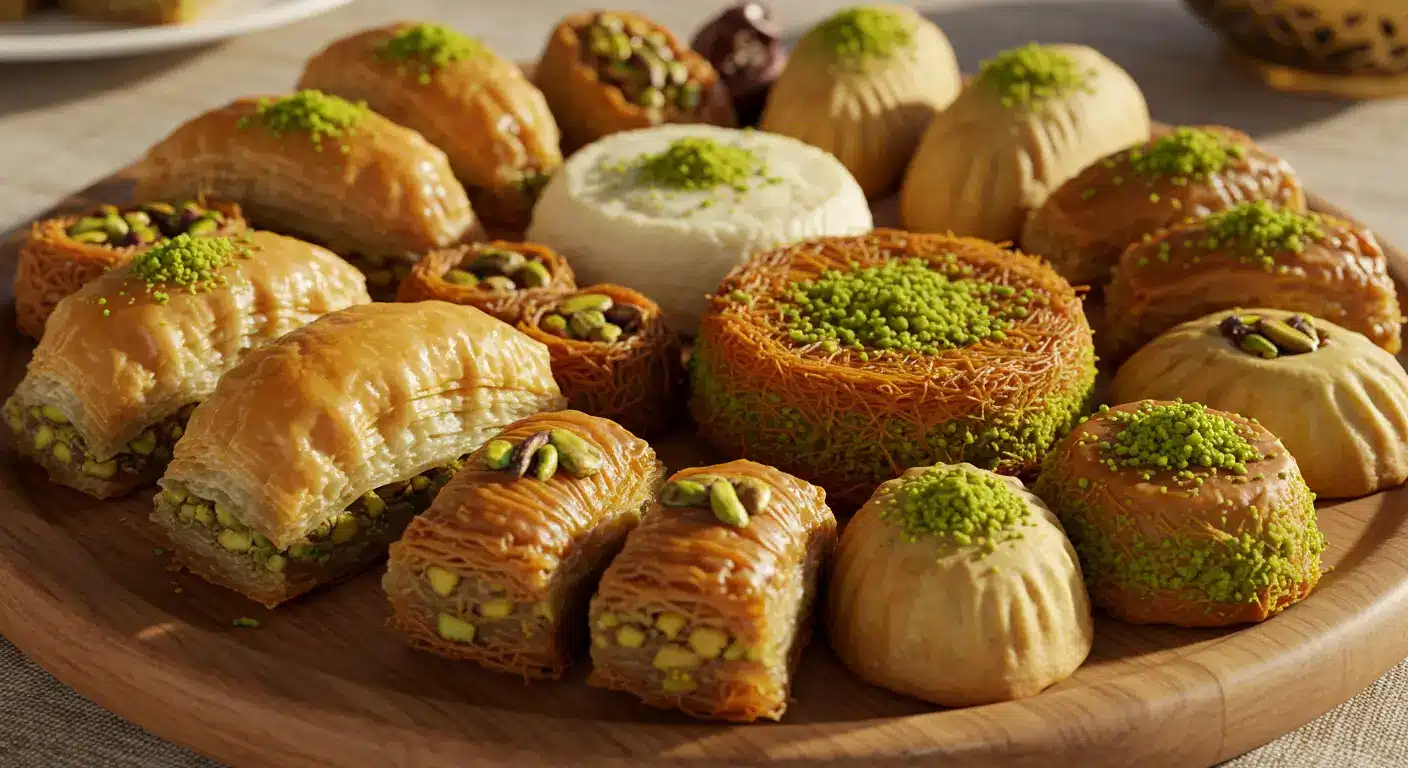Middle Eastern Desserts: The Most Irresistible Treats from the Region
Middle Eastern desserts are known for their rich flavors, delicate textures, and vibrant cultural roots. From the honey-soaked layers of baklava to the creamy delight of rice pudding, these sweets offer a mouthwatering window into centuries-old traditions.
In this article, we’ll dive deep into the world of Middle Eastern desserts—exploring their history, top recipes, unique ingredients, regional twists, and modern-day variations. Whether you’re planning to make these treats at home or simply looking to discover something new, you’ll find delicious insights worth savoring.
Don’t miss our ultimate guide to Middle Eastern Desserts for more inspirations.
Table of Contents
The Rich History of Middle Eastern Desserts
Origins of Middle Eastern Sweets in Ancient Civilizations
Middle Eastern desserts have roots stretching back thousands of years. Ancient Mesopotamians were among the first to combine nuts, fruits, and honey into early forms of sweets. Over time, sugar replaced honey, and recipes evolved into more elaborate desserts still enjoyed today.
In Egypt, evidence shows sweet pastries made with dates and nuts were offered to pharaohs. In Persia, saffron and rose water became common in sweet dishes, adding fragrant, floral notes that define many Middle Eastern desserts today.
These ancient confections weren’t just food—they were symbols of hospitality, love, and celebration.
Influences from Persia, Ottoman Empire, and the Levant
The diversity in Middle Eastern desserts comes from the region’s rich mix of cultures. Persian, Ottoman, Arab, and Levantine influences all played key roles in shaping regional sweets.
Persia brought ingredients like pistachios, cardamom, and rose water. The Ottoman Empire introduced techniques like layering phyllo dough, which became central to pastries like baklava. The Levant—home to Lebanon, Syria, Jordan, and Palestine—gave us treats like maamoul and kanafeh.
As these empires expanded, so did their culinary secrets. Traders and conquerors helped spread desserts across borders, adapting recipes to local tastes and ingredients.
Dessert Culture in Middle Eastern Celebrations and Traditions
Desserts aren’t just a post-meal treat in the Middle East—they’re central to social gatherings, religious holidays, and family life. During Ramadan, sweets like qatayef and basbousa are prepared for iftar. On Eid, homes overflow with cookies like maamoul.
Weddings, birthdays, and even funerals feature specific desserts meant to mark the occasion. Each sweet carries meaning and memory, handed down through generations.
This deep cultural connection is part of what makes Middle Eastern desserts so special—and so beloved worldwide.
Check out Greek Desserts to see how they compare with Levantine sweets.
Top 10 Must-Try Traditional Middle Eastern Desserts

Baklava: Layers of History and Honeyed Phyllo
Baklava is perhaps the most iconic Middle Eastern dessert. Made with paper-thin phyllo dough, finely chopped nuts—usually pistachios or walnuts—and soaked in syrup or honey, this layered pastry is crispy, rich, and unbelievably satisfying.
Its origins are debated among Turks, Arabs, and Greeks, but one thing’s for sure: baklava is a masterpiece of flaky sweetness. It’s commonly served during holidays, weddings, and big family gatherings.
Many modern versions include chocolate, fruit fillings, or even cream cheese—but the classic still reigns supreme.
Kanafeh: A Cheese Lover’s Dream Dessert
Kanafeh (or kunafa) is a standout dessert across the Levant and the Gulf. It’s made by layering shredded phyllo dough—or semolina dough—around a filling of soft cheese. The entire dish is baked until golden, then drenched in orange blossom syrup.
This contrast of crunchy top and gooey center makes kanafeh utterly addictive. Originating from Nablus, Palestine, the most popular version is Kanafeh Nabulsieh, colored with orange dye and garnished with crushed pistachios.
Kanafeh is often eaten during Ramadan, especially for Suhoor or Iftar.
Basbousa: A Semolina Cake Soaked in Syrup
Basbousa is a moist semolina cake that’s sweet, buttery, and slightly nutty. It’s made with basic ingredients like semolina, sugar, yogurt, and coconut, then baked and drenched in simple syrup after coming out of the oven.
The syrup gives it a sticky-sweet finish without overpowering the cake’s light crumb. You’ll find basbousa across Egypt, Lebanon, and Syria, often garnished with almonds or coconut flakes.
This dessert pairs beautifully with black tea or Arabic coffee.
Qatayef: Sweet Pancakes Stuffed with Nuts and Cream
Qatayef is a Ramadan-exclusive sweet in many Middle Eastern households. These are small, fluffy pancakes stuffed with cream, nuts, or even sweet cheese, folded and either baked or deep-fried.
The outer layer is spongy and tender, while the inside bursts with flavor. Once stuffed, they’re typically drizzled with syrup flavored with rose or orange blossom water.
In many families, making qatayef is a beloved Ramadan tradition passed through generations.
Maamoul: Date-Filled Delicacies for Eid
Maamoul are shortbread-like cookies filled with dates, nuts, or figs. They’re often pressed into beautiful molds, giving each piece an ornate, decorative finish.
These cookies are especially popular during Eid celebrations and are usually prepared in large batches to serve visiting guests. Common fillings include walnuts and pistachios, mixed with cinnamon or cardamom.
Their rich, buttery flavor is perfectly balanced with the sweetness of the filling.
Zalabia: Middle Eastern Donuts Drenched in Sugar
Zalabia, also known as luqaimat or awamat, are crispy donut balls that are deep-fried to golden perfection and dipped in sugar syrup or honey.
They’re quick to make and super satisfying. The outside is crunchy, while the inside is airy and soft. These are street food favorites during festivals and Ramadan nights.
Sprinkle some sesame seeds or powdered sugar on top for a finishing touch.
Halva: A Sesame-Based Classic with Variations
Halva comes in many forms, but the tahini-based version is the most widely known in the Middle East. It’s dense, crumbly, and sweet, often infused with pistachios, chocolate, or vanilla.
Made with sesame paste and sugar, halva is high in flavor and nutrition. It can be enjoyed as a dessert, a snack, or even breakfast with bread.
There are also flour-based and semolina-based halvas popular in Iran and Iraq.
Knafeh Nabulsieh: Palestinian Favorite with Orange Glow
While kanafeh comes in various styles, Knafeh Nabulsieh stands out for its specific texture and presentation. It’s made with fine semolina dough and unsalted cheese, baked and soaked in syrup, then colored with bright orange dye.
The garnish? A thick layer of crushed pistachios.
Its stretchy cheese layer and bold flavor make it an unforgettable dish. Don’t miss our feature on Middle Eastern desserts to learn more.
Atayef Asafiri: Bite-Sized Crepes for Ramadan
This version of qatayef is served fresh and un-fried. The small crepes are folded into cones and filled with fresh cream or ashta (clotted cream), then sprinkled with pistachios and drizzled with syrup.
They’re light, fresh, and perfect for a quick dessert bite after a heavy iftar meal.
Atayef asafiri are also popular for entertaining guests and make a beautiful addition to any dessert tray.
Rice Pudding (Roz Bel Laban): Creamy Comfort Food
Simple yet deeply comforting, rice pudding—known as Roz Bel Laban—is a common dessert across Egypt and the Middle East. Made from milk, rice, and sugar, it’s often flavored with vanilla, cinnamon, or orange blossom.
Some recipes include cornstarch for a thicker consistency. It’s usually served chilled and topped with nuts, cinnamon, or raisins.
A beloved choice for kids and adults alike, this dish is both nostalgic and satisfying.
What Makes Middle Eastern Pastries So Unique?
Phyllo Dough and Nut-Based Combinations
One of the most defining features of Middle Eastern pastries is their use of phyllo dough—those thin, flaky sheets that bake into crispy, golden layers. Combined with crushed nuts like pistachios, almonds, or walnuts, phyllo is the backbone of legendary desserts like baklava, knafeh, and atayef.
These pastries aren’t just sweet—they’re textural experiences. Every bite offers a contrast of crunch and softness, held together by aromatic syrups or fragrant creams. Whether folded, rolled, or layered, phyllo dough elevates simple ingredients into extraordinary sweets.
The nut fillings bring richness and depth. Pistachios are the most prized and widely used, adding earthy color and a buttery crunch.
Sweet Syrups with Rose and Orange Blossom Water
Rather than relying only on sugar, Middle Eastern desserts are sweetened with scented syrups—often infused with rose water, orange blossom water, or lemon juice. These syrups add flavor and moisture while preventing desserts from becoming overly sugary.
Imagine biting into a warm piece of basbousa, the syrup soaked all the way to the center, releasing a soft floral note that lingers after each bite. Or tasting kanafeh, with syrup cascading through its shredded dough crust into the cheese core—it’s magic.
These flavors create a signature profile that instantly identifies a dessert as authentically Middle Eastern.
The Use of Ghee, Dates, Semolina, and Saffron
Middle Eastern desserts rely on a few bold ingredients that deliver intense flavor and lasting impact. Ghee—a type of clarified butter—adds a nutty richness and is favored over regular butter for many traditional recipes.
Dates serve as both a natural sweetener and a key ingredient in cookies like maamoul. Soft, sticky, and deeply flavorful, dates are also packed with nutrients and symbolize hospitality across the region.
Semolina flour is another staple, used in cakes like basbousa or desserts like harissa. It provides a coarser, denser crumb compared to all-purpose flour, making sweets feel heartier.
Lastly, saffron—used sparingly but powerfully—adds color, fragrance, and subtle earthy tones to luxury treats. It’s often found in Persian and Gulf desserts like saffron rice pudding or halwa.
Don’t miss our Greek dessert inspirations to see how they compare.
Exploring Regional Dessert Variations Across the Middle East

Levantine vs. Gulf Sweets: What Sets Them Apart?
The Middle East is a tapestry of cultures, and that diversity shines brightest in its desserts. The Levant region—including Lebanon, Syria, Jordan, and Palestine—is known for its refined pastries. Sweets like knafeh, atayef, and maamoul dominate here, often using nuts, rose water, and semolina.
In contrast, Gulf countries such as Saudi Arabia, Kuwait, and the UAE lean toward date-rich desserts and spiced sweets like luqaimat, saffron halwa, and khabeesa. These are simpler but packed with warming flavors like cardamom, ghee, and cloves.
While Levantine desserts are often oven-baked, Gulf sweets tend to be deep-fried or slow-cooked on the stove.
Egyptian, Lebanese, Palestinian, and Syrian Specialties
Egyptian desserts offer rich, syrup-soaked creations like basbousa, umm ali (a Middle Eastern bread pudding), and roz bel laban (rice pudding). Egypt favors semolina, coconut, and nuts in many of its sweets.
Lebanon is famous for its artistry in dessert-making. From perfectly shaped maamoul to rose-scented layali lubnan (Lebanese nights pudding), the emphasis is on balance and fragrance.
In Palestine, knafeh nabulsieh stands out as a national treasure. It’s made with a semolina crust, soft cheese, and a bright orange hue. This version of knafeh is especially loved during holidays and weddings.
Syria brings sophistication to the table with intricate baklava assortments, pistachio-rich sweets, and creamy dishes like muhallabia, a milk pudding flavored with mastic and rose water.
Iraqi Kleicha vs. Turkish Lokum (Turkish Delight)
Kleicha is Iraq’s signature cookie, made with a spiced date filling and often served during Eid. The dough is rolled and shaped with unique stamps, giving each piece a traditional look. It’s a symbol of hospitality in Iraqi homes.
Turkish lokum, also known as Turkish delight, is known for its soft, chewy texture and wide variety of flavors. While it’s native to Turkey, lokum is widely enjoyed across the Middle East, particularly during festive seasons. It’s dusted with powdered sugar and flavored with rose, lemon, or pomegranate.
These two sweets show how deeply regional identity is woven into dessert-making.
Discover great ideas like crescent roll cinnamon rolls that echo the flaky layers of Middle Eastern pastries.
Looking for soft, chewy bites? Don’t miss our delightful Asian desserts with similar textures.
Common Ingredients in Middle Eastern Desserts

Essential Pantry Items: Semolina, Ghee, Pistachios, Dates
When it comes to crafting authentic Middle Eastern desserts, there are a few ingredients you’ll always find in the pantry. Semolina tops the list. This coarse flour made from durum wheat is the base of beloved treats like basbousa, harissa, and even some types of halva. It creates a distinct, grainy texture that sets these sweets apart from cakes made with all-purpose flour.
Ghee, or clarified butter, is another must-have. It’s used in place of oil or regular butter and brings a deep, nutty flavor. Whether you’re layering phyllo for baklava or roasting nuts, ghee adds rich complexity that defines the taste of traditional sweets.
Then there are pistachios—the jewel of Middle Eastern desserts. They’re used for fillings, toppings, and garnishes in everything from knafeh to halva. Their vibrant green hue and sweet nuttiness elevate every dish.
And of course, dates. Naturally sweet and sticky, dates are the heart of desserts like maamoul and kleicha. They’re often blended into pastes or chopped and folded into cookies, bringing warmth and richness to the table.
Popular Spices: Cardamom, Cinnamon, and Clove
Spices are the soul of Middle Eastern desserts. These aren’t just sweet treats—they’re aromatic experiences.
Cardamom leads the charge. Its citrusy, herbal flavor is used in cookies, puddings, and even syrups. You’ll often find it paired with dates or nuts, especially in desserts served during Eid or Ramadan.
Cinnamon follows closely behind. It’s not only used in baking but also added to syrups and dusted over puddings. Whether you’re making rice pudding or stuffed qatayef, cinnamon enhances sweetness while offering depth.
Clove brings a bold, warming bite. It’s strong, so it’s used sparingly—usually in spice blends or syrups. In some regions, it’s added to sweets like kleicha for a rich, almost peppery note.
These spices aren’t random—they’re rooted in centuries-old culinary traditions and serve both flavor and symbolic roles in Middle Eastern cultures.
Sweeteners: Sugar Syrup, Date Syrup, and Honey
Sugar is sweet, but in the Middle East, it’s often upgraded into something more fragrant. Simple syrup—made by boiling sugar with water, lemon, and floral waters—is a cornerstone of desserts like baklava, basbousa, and kanafeh.
Rose water and orange blossom water are common additions, giving the syrup a perfumed touch that seeps into every layer of a pastry.
Date syrup, or dibs, is another natural sweetener used throughout the Gulf region. It’s rich, dark, and packed with nutrients. You’ll find it in stuffed pastries, pancakes, and even drizzled over yogurt.
Honey rounds out the sweetener spectrum. While less dominant than syrup, it’s often used in Mediterranean-leaning sweets and newer fusion recipes. Its delicate floral notes pair wonderfully with ingredients like nuts, tahini, and fruits, enhancing both aroma and flavor.
How to Make Middle Eastern Desserts at Home
Baking Tools and Techniques You’ll Need
Making Middle Eastern desserts at home doesn’t require a professional kitchen—just a few key tools and techniques. First, you’ll need a baking tray for recipes like baklava, basbousa, and maamoul. A food processor is handy for blending dates, grinding nuts, or making tahini-based halva.
A pastry brush is essential when working with phyllo dough, allowing you to evenly spread ghee or butter between paper-thin sheets. You’ll also want measuring cups and spoons—precise proportions matter when working with syrups and spices.
For some recipes like kanafeh, a shallow round pan works best to create that traditional crust and uniform shape. And don’t forget a fine mesh strainer for dusting powdered sugar or sifting semolina.
In terms of technique, layering is key. Many Middle Eastern sweets involve stacking or folding phyllo or dough, then soaking the finished dessert in warm syrup. This requires patience—but the payoff is pure indulgence.
Step-by-Step for Beginners: Making Basbousa and Baklava
Want to try your hand at something easy but authentic? Start with basbousa. Here’s a simple step-by-step guide:
Easy Basbousa Recipe
- In a bowl, mix 1 cup semolina, ½ cup sugar, ½ cup yogurt, ¼ cup melted ghee, and ¼ tsp baking powder.
- Pour the batter into a greased baking dish.
- Score into diamond shapes and top each piece with an almond.
- Bake at 350°F for 30–35 minutes until golden.
- While it bakes, prepare syrup by boiling ½ cup sugar with ½ cup water and a few drops of rose water.
- Pour syrup over hot basbousa and let it soak.
Craving something more advanced? Try baklava:
Beginner-Friendly Baklava
- Grease a baking pan and carefully layer 10 sheets of phyllo dough, brushing each sheet with melted ghee.
- Sprinkle a mix of chopped walnuts, pistachios, and cinnamon.
- Add another 10 phyllo sheets on top, repeating the ghee brushing.
- Cut into diamonds before baking at 325°F for 45 minutes.
- Pour hot sugar syrup (infused with orange blossom) over the pastry right out of the oven.
- Let it cool before serving.
These desserts don’t just taste good—they bring the warm, aromatic kitchen vibes of the Middle East right into your home.
Time-Saving Tips and Substitutions
Short on time? You can still enjoy Middle Eastern desserts with a few smart hacks.
- Phyllo too tricky? Use puff pastry for a crisp but manageable baklava shortcut.
- No ghee? Use unsalted butter, clarified if possible.
- Missing rose water? Try a light splash of vanilla and lemon zest for aroma.
- Need a dairy-free version? Use coconut yogurt in basbousa and nut-based cheese in kanafeh.
Pre-made date paste, nut blends, and store-bought syrups can also shave down prep time without compromising flavor.
Looking for flaky pastry alternatives? Discover puff pastry desserts inspired by Middle Eastern baking.
Conclusion
Middle Eastern desserts are more than just sweet treats—they’re edible traditions, rich with culture, flavor, and history. From the flaky layers of baklava to the creamy elegance of rice pudding, every bite carries a story of centuries-old culinary craft.
Whether you’re celebrating a holiday, hosting guests, or just satisfying a sweet tooth, there’s a Middle Eastern dessert that fits the moment. And the best part? Many of these recipes are simple enough to make at home, bringing global flavor into your own kitchen.
So, whether you’re exploring traditional sweets or testing out middle eastern desserts recipes, let the spices, syrups, and textures of the Middle East inspire your next dessert adventure.
FAQs
What is a popular Arabic dessert?
One of the most popular Arabic desserts is baklava, known for its flaky phyllo layers filled with nuts and soaked in syrup. Other favorites include maamoul (date-filled cookies), knafeh (cheese pastry), and basbousa (semolina cake).
Each dish represents different regions but shares common flavors like rose water, cardamom, and ghee.
What are Middle Eastern pastries?
Middle Eastern pastries are sweet treats typically made with phyllo dough, semolina, or dates. They include iconic items like baklava, atayef, and maamoul. These pastries often feature fillings made of pistachios, walnuts, or sweet cheese, and are soaked in fragrant syrups.
Most are enjoyed during religious holidays or family celebrations.
What are some Mediterranean desserts?
Mediterranean desserts include a wide variety of treats like Greek galaktoboureko, Italian cannoli, Spanish turrón, and Turkish delight. They share ingredients with Middle Eastern sweets—such as honey, almonds, and citrus—but often use dairy-rich custards and pastries instead of syrup-soaked layers.
What are five common desserts?
Here are five classic Middle Eastern desserts you’ll find across the region:
Baklava – Flaky phyllo, nuts, and syrup.
Knafeh – Crispy dough with melted cheese.
Basbousa – Semolina cake with syrup.
Maamoul – Date or nut-filled cookies.
Luqaimat – Fried dough balls with honey.
Each is packed with flavor and represents a rich cultural heritage.
What are the 4 main desserts?
While regional preferences vary, four core Middle Eastern desserts found throughout the region are:
Baklava
Knafeh
Halva
Basbousa
These sweets reflect the essential ingredients of Middle Eastern dessert culture—nuts, syrup, semolina, and aromatic spices.
What is the #1 dessert in the world?
There’s no single winner, but baklava is often considered one of the most loved desserts globally. Its perfect balance of crunch, sweetness, and aroma makes it a favorite not just in the Middle East, but also in parts of Europe, the U.S., and beyond.
Its appeal lies in both its traditional roots and its modern variations.

